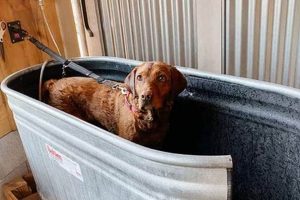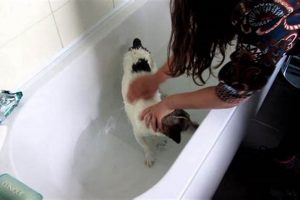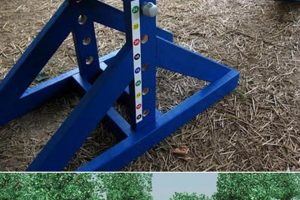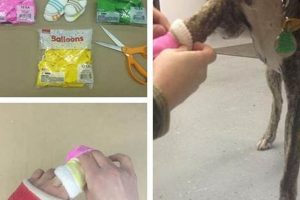The creation of attire for canines, achieved through do-it-yourself methods, involves crafting personalized outfits for pets using readily available materials and individual skills. This practice allows for the design and construction of garments tailored to specific animal dimensions, preferences, and occasions. Examples range from simple bandanas to elaborate thematic ensembles.
This form of pet apparel creation provides several advantages. It offers a cost-effective alternative to purchasing pre-made items, fostering resourcefulness and creativity. Historically, customizing animal wear reflects a broader trend of human-animal bonding and the desire to personalize a pet’s appearance. Moreover, this activity allows owners to ensure proper fit and comfort, minimizing potential distress for the animal.
The subsequent discussion will explore various techniques, material choices, and design considerations relevant to constructing custom-made garments for canine companions. Considerations encompass safety, comfort, and appropriate construction methods.
Tips for Canine Apparel Construction
Effective creation of pet attire requires careful planning and execution. The following suggestions promote successful and safe results.
Tip 1: Prioritize Canine Comfort: Select soft, breathable fabrics to prevent overheating and skin irritation. Ensure unrestricted movement by allowing ample room around joints and limbs.
Tip 2: Accurate Measurement is Critical: Precise measurements are essential for a well-fitting garment. Measure the dog’s neck, chest girth, and back length to create a tailored pattern.
Tip 3: Emphasize Safety Features: Avoid small, detachable embellishments that could pose a choking hazard. Reflective tape or bright colors can enhance visibility during nighttime walks.
Tip 4: Simple Designs Minimize Stress: For novice creators, opt for straightforward designs with minimal closures. Complex patterns can be challenging and may cause discomfort if poorly executed.
Tip 5: Utilize Durable and Washable Materials: Choose fabrics that withstand regular washing and wear. Reinforce seams to prevent tearing and extend the garment’s lifespan.
Tip 6: Consider Fastener Placement Carefully: Position fasteners, such as Velcro or snaps, away from areas where they could rub against the dog’s skin. Ensure they are securely attached.
Tip 7: Test Fit During Construction: Regularly test the fit of the garment during the construction process. This allows for adjustments to ensure comfort and proper sizing.
Adhering to these recommendations will improve the success rate of crafting safe, comfortable, and aesthetically pleasing canine apparel.
The subsequent section will address specific design considerations and material selection in greater detail.
1. Appropriate Fabric Selection
Fabric selection exerts a substantial influence on the comfort, safety, and durability of canine apparel. When engaging in do-it-yourself garment construction for dogs, the choice of material directly impacts the animal’s well-being and the garment’s longevity. Inappropriate fabric choices can lead to skin irritation, overheating, restricted movement, and premature wear. For example, using non-breathable synthetic fabrics can trap heat, leading to discomfort and potential health risks, especially in warmer climates or during physical activity. Conversely, materials that are too delicate may tear easily, rendering the garment unsuitable for regular use. The selection of appropriate materials is therefore a prerequisite for successful “costumes for dogs diy”.
Considerations when selecting suitable fabrics include breathability, weight, texture, and washability. Breathable fabrics, such as cotton or linen blends, allow for adequate ventilation, reducing the risk of overheating and skin irritation. Lightweight fabrics are preferable, particularly for smaller breeds or warmer climates, as they minimize the garment’s burden on the animal. A smooth texture prevents chafing and irritation, while washability simplifies maintenance and ensures hygiene. Durable fabrics, like denim or canvas, can withstand wear and tear, extending the garment’s lifespan. Conversely, avoid fabrics with loose weaves or embellishments that can be easily ingested.
In conclusion, the practice of creating garments for canines necessitates careful fabric evaluation. The optimal choice promotes comfort, safety, and durability, directly influencing the success and practicality of the “costumes for dogs diy” endeavor. Ignoring these considerations can result in garments that are either uncomfortable, unsafe, or prone to rapid degradation. Therefore, prioritizing fabric selection is fundamental to ethical and effective canine apparel construction.
2. Precise Measurement Techniques
Accurate measurement constitutes a foundational element in the successful execution of self-made canine apparel. Discrepancies in dimensional data directly influence the fit, comfort, and functionality of the resulting garment. Inaccurate measurements, for instance, can lead to constricting necklines, improperly placed leg holes causing chafing, or body lengths insufficient to provide adequate coverage. These issues can cause significant discomfort for the animal, rendering the crafted item unusable. A scenario involving a chest girth measurement underestimate might result in a garment too tight, impeding the dog’s breathing and movement. Conversely, an overestimated back length could produce an overly long garment, presenting tripping hazards or interfering with natural bodily functions. Therefore, mastering and applying precise measurement techniques is not merely advisable but rather a critical prerequisite for effective and humane apparel crafting.
The practical application of these techniques involves several key steps. First, utilize a flexible measuring tape for accurate contour tracing of the dog’s body. Standard measurement points include neck circumference, chest girth (measured at the widest point), back length (from the base of the neck to the base of the tail), and leg length (if applicable). Employ consistent tension on the measuring tape to avoid introducing slack or constriction. Obtain multiple measurements and calculate an average to mitigate the impact of potential variations. Furthermore, acknowledge breed-specific anatomical differences, such as the deep chests of Greyhounds or the short legs of Dachshunds, and adjust measurements accordingly to accommodate these unique traits. Accurate recording and subsequent application of these data points directly translate into appropriately sized pattern pieces, minimizing the need for extensive alterations during the construction phase.
In summation, the integration of precise measurement techniques within the “costumes for dogs diy” process is indispensable for ensuring pet well-being and garment functionality. Overlooking this fundamental aspect can lead to discomfort, restricted movement, and potentially hazardous situations for the canine. The conscientious application of these techniques, combined with an understanding of breed-specific anatomy, fosters the creation of comfortable, safe, and well-fitting apparel. This focus ultimately transforms the endeavor from a mere craft project into a responsible act of pet care and enrichment.
3. Secure Fastener Placement
The integration of secure fastener placement within the realm of self-fabricated canine attire directly impacts the garment’s functionality, the animal’s comfort, and overall safety. Inadequate fastener design and implementation can lead to garment instability, potential choking hazards, and skin irritation. The subsequent discussion elucidates critical considerations pertaining to fastener selection and application in the context of “costumes for dogs diy.”
- Minimizing Chafing and Irritation
Fasteners positioned in areas prone to friction, such as under the limbs or along the abdomen, can induce chafing or skin irritation. Opting for smooth, low-profile fasteners, and strategically placing them away from direct skin contact, mitigates this risk. An example is utilizing a wide, soft Velcro strip along the back rather than snaps under the chest. Incorrect placement can lead to discomfort and potential dermatological issues.
- Preventing Accidental Ingestion
Small, detachable fasteners, such as buttons or loosely sewn snaps, pose a significant choking hazard if ingested. Selecting larger, more robust fasteners and ensuring their secure attachment to the garment is paramount. Reinforcement stitching around snap attachments and careful selection of button sizes are crucial preventive measures. Failure to prioritize this consideration can lead to serious health consequences for the animal.
- Ensuring Garment Stability and Fit
The type and placement of fasteners directly influence the garment’s ability to remain securely in place during movement. Inadequate fastener systems can lead to slippage, twisting, or complete dislodgement of the garment. Strategic placement of multiple fasteners, such as a combination of Velcro straps and buckles, enhances stability. A single, weak fastener may prove insufficient to maintain the garment’s position during activity.
- Facilitating Ease of Application and Removal
Fastener design must consider the ease with which the garment can be applied and removed. Overly complex or difficult-to-manipulate fasteners can cause undue stress to the animal and the handler. Simple, intuitive fastener systems, such as Velcro or adjustable buckles, streamline the dressing process. A complicated series of snaps or ties may be impractical for everyday use.
In conclusion, secure fastener placement represents a critical aspect of “costumes for dogs diy.” Thoughtful fastener selection and strategic implementation contribute directly to the garment’s safety, comfort, and functionality. Neglecting these considerations compromises the overall quality of the constructed item and potentially jeopardizes the well-being of the animal. Prioritizing secure and comfortable fastener systems transforms the act of creating canine apparel from a simple craft into a responsible act of pet care.
4. Comfortable Design Adaptation
The intersection of comfortable design adaptation and self-constructed canine attire is paramount to the welfare and acceptance of the garment by the animal. The core tenet of this intersection is to modify pre-existing patterns or create novel designs that accommodate the unique anatomical features, behavioral patterns, and sensitivities of individual dogs. A failure to adapt designs for comfort results in garments that are restrictive, irritating, or anxiety-inducing, negating any aesthetic value. Consider, for example, a pattern designed for a short-haired breed being implemented without alteration on a long-haired breed. The dense fur may cause overheating, discomfort, and potential skin issues due to restricted airflow. Thus, adapting the pattern to incorporate a looser fit and breathable materials becomes essential. The practical significance is that an uncomfortable garment will likely be resisted by the dog, rendering the creation effort futile and potentially causing distress to the animal.
Furthermore, adaptation must extend beyond mere fit to encompass functional considerations. A design element, such as a decorative embellishment, might be aesthetically pleasing but present a snagging hazard during normal canine activities like running or playing. Similarly, closures positioned in areas accessible to chewing can rapidly lead to garment destruction and potential ingestion of small parts. Adaptations might include relocating closures to the back or using durable, chew-resistant materials in vulnerable areas. The goal is to anticipate potential sources of discomfort or hazard and proactively modify the design to mitigate these risks. Practical applications include reinforced seams in high-stress areas, the use of flexible materials around joints to allow for free movement, and the elimination of protruding elements that could be caught on objects.
In summation, comfortable design adaptation is not an optional consideration but a central determinant of success in self-constructed canine apparel. The ability to critically assess design elements, anticipate potential sources of discomfort or hazard, and skillfully modify patterns to accommodate individual canine needs reflects a responsible and ethical approach. The inherent challenges lie in accurately assessing canine behavior and anatomical variation. However, prioritizing comfort adaptation ensures that the “costumes for dogs diy” endeavor results in a wearable, safe, and enriching experience for both the owner and the canine companion.
5. Choking Hazard Prevention
Choking hazard prevention is a critical, non-negotiable aspect of creating canine attire through do-it-yourself methods. The inherent risk of small components detaching from self-made garments necessitates meticulous attention to design and construction. The incorporation of elements such as buttons, beads, ribbons, or loosely attached decorative pieces introduces a significant choking hazard for canines, who often explore their environment and objects with their mouths. A detached embellishment, if ingested, can obstruct the airway, leading to asphyxiation, or cause intestinal blockage, necessitating surgical intervention. Instances of dogs requiring emergency veterinary care due to ingesting components from homemade attire underscore the severity of this concern. Prioritizing choking hazard prevention is, therefore, not merely a recommendation but an ethical imperative in the pursuit of crafting canine costumes.
Practical strategies for mitigating choking hazards include the elimination of small, detachable components whenever feasible. When embellishments are deemed essential, they must be securely affixed using industrial-strength adhesives and reinforced stitching. Regular inspection of the garment for loose or damaged elements is crucial, with prompt repair or removal of any potential hazards. The selection of materials should also prioritize durability and resistance to chewing, minimizing the likelihood of disintegration and subsequent ingestion. Furthermore, the design should avoid long, dangling elements that could be easily grabbed and pulled off. An example includes using embroidered designs rather than glued-on decorations.
In summary, the responsible creation of canine attire necessitates a proactive and uncompromising approach to choking hazard prevention. The potential consequences of neglecting this critical aspect range from severe distress to life-threatening emergencies for the animal. The adoption of stringent safety measures, including meticulous material selection, robust construction techniques, and vigilant monitoring, transforms a potentially hazardous activity into a safe and enriching experience. The challenges associated with ensuring complete safety should not deter individuals from engaging in “costumes for dogs diy,” but rather serve as a constant reminder of the ethical responsibility inherent in creating items intended for animal use.
6. Durability and Washability
The successful integration of durability and washability into self-fabricated canine attire is paramount to the garment’s longevity, hygiene, and overall value. In the context of “costumes for dogs diy,” these attributes directly influence the practicality and sustainability of the crafting endeavor. Garments lacking in durability are prone to tearing, seam separation, and material degradation, resulting in a short lifespan and frequent need for replacement. Similarly, the inability to effectively clean the attire promotes the accumulation of dirt, allergens, and pathogens, potentially leading to skin irritation, unpleasant odors, and the transmission of diseases. Therefore, the selection of appropriate materials and construction techniques, which contribute to both durability and washability, constitutes a fundamental consideration in canine apparel creation. For example, a costume constructed from delicate fabrics with intricate embellishments may be visually appealing, but its susceptibility to damage during routine canine activities and its impracticality for laundering render it unsuitable for sustained use. The causal relationship is clear: inadequate durability and washability directly diminish the value and usability of self-made canine attire.
The practical application of these principles involves several key considerations. Durable fabrics, such as tightly woven cotton blends, canvas, or denim, offer resistance to tearing and abrasion. Reinforcing seams with multiple rows of stitching or using serged edges prevents fraying and separation. Embellishments should be securely attached using robust adhesives and stitching techniques that can withstand repeated washing cycles. Furthermore, selecting materials that are colorfast and resistant to shrinking ensures that the garment maintains its appearance and fit after laundering. Washability considerations include choosing fabrics that can be machine washed and tumble dried without damage or distortion. The use of pre-shrunk fabrics minimizes the risk of dimensional changes after the first wash. The incorporation of features such as removable embellishments or washable linings simplifies the cleaning process and extends the garment’s lifespan. An example would be creating a base costume of durable, washable material and adding decorative elements that can be easily removed before laundering.
In conclusion, the emphasis on durability and washability in “costumes for dogs diy” is not merely a matter of convenience but rather a prerequisite for creating functional, hygienic, and sustainable canine apparel. Garments that withstand the rigors of canine activity and can be effectively cleaned offer superior value and contribute to the animal’s well-being. The challenge lies in balancing aesthetic considerations with practical requirements, selecting materials and construction techniques that optimize both durability and washability without compromising the garment’s visual appeal. Addressing these considerations transforms the creation of canine attire from a fleeting hobby into a responsible and rewarding endeavor.
7. Simplicity for Pet Tolerance
The correlation between uncomplicated designs and canine acceptance constitutes a significant determinant in the successful implementation of “costumes for dogs diy.” A direct inverse relationship often exists between the complexity of a garment and the likelihood of a dog tolerating its presence. Elaborate constructions, featuring multiple layers, restrictive closures, or cumbersome embellishments, frequently induce stress, anxiety, and resistance in animals. This negative response stems from the garment’s interference with natural movement, sensory overload, or physical discomfort. The practical consequence is that an intricately designed costume, regardless of its aesthetic appeal to humans, may remain unworn due to canine aversion. A real-world example is a multi-layered, heavily adorned costume triggering anxiety in a dog, causing it to exhibit signs of distress, such as panting, pacing, or attempting to remove the garment. Simplicity, therefore, serves as a foundational element in ensuring canine comfort and promoting positive associations with attire.
Further analysis reveals that design simplification extends beyond the physical attributes of the garment to encompass ease of application and removal. Complex fastening systems, requiring prolonged manipulation or causing pulling sensations, can elicit negative reactions from dogs. Streamlined designs, incorporating minimal closures and allowing for rapid application and removal, foster cooperation and reduce stress. Practical applications include utilizing Velcro closures instead of multiple snaps or designing garments that slip easily over the head. The judicious application of simplicity principles translates directly into improved canine tolerance, enhancing the likelihood that the garment will be worn willingly and comfortably. This, in turn, contributes to the overall success and ethical considerations of “costumes for dogs diy.”
In conclusion, the principle of “Simplicity for Pet Tolerance” represents a cornerstone in the responsible creation of canine attire. The challenges associated with accurately assessing canine sensory sensitivities and behavioral responses necessitate a deliberate focus on minimizing complexity and maximizing comfort. By prioritizing simple designs, easy application, and the avoidance of restrictive or irritating elements, individuals engaging in “costumes for dogs diy” can create garments that are not only visually appealing but also ethically sound and promote the well-being of their canine companions. The broader theme underscores the importance of prioritizing animal welfare over purely aesthetic considerations in all aspects of pet-related activities.
Frequently Asked Questions About Canine Costume Construction
The following section addresses common inquiries regarding the creation of canine costumes through do-it-yourself methods, providing informative responses to ensure safety and success.
Question 1: What fabrics should be avoided when constructing attire for dogs?
Fabrics that are not breathable, such as tightly woven synthetics like vinyl or non-breathable polyester, should be avoided. These materials can trap heat and moisture, leading to overheating and skin irritation. Similarly, materials with loose weaves or easily detachable fibers pose a choking hazard and should be excluded.
Question 2: How can accurate measurements be obtained for a canine costume?
Accurate measurements require a flexible measuring tape and a cooperative dog. Measure the neck circumference, chest girth, and back length. Ensure the dog is standing squarely, and avoid pulling the tape too tightly. Multiple measurements should be taken and averaged to minimize error.
Question 3: What are the key considerations for fastener placement on a dog costume?
Fasteners should be positioned away from areas of friction, such as under the legs or around the neck. They must be securely attached to prevent detachment and potential ingestion. Velcro or smooth snaps are preferable to buttons or hooks, minimizing the risk of irritation or injury.
Question 4: How can costume designs be adapted for canine comfort?
Designs should prioritize freedom of movement and avoid constricting areas around the neck, chest, or limbs. Lightweight, breathable materials are essential. Seams should be smooth and positioned away from sensitive areas. Avoid excessive embellishments or bulky layers that could cause overheating or discomfort.
Question 5: What steps can be taken to prevent choking hazards in self-made dog costumes?
Small, detachable components, such as buttons, beads, or ribbons, should be avoided. If embellishments are necessary, they must be securely attached with strong adhesives and reinforced stitching. Regular inspection of the costume for loose or damaged parts is essential.
Question 6: How can the durability and washability of a canine costume be ensured?
Durable fabrics, such as tightly woven cotton blends or canvas, should be selected. Seams should be reinforced with multiple rows of stitching or serged edges. Colorfast and pre-shrunk materials are recommended. Garments should be machine washable and tumble dry-able for ease of care.
Prioritizing safety, comfort, and proper construction techniques are crucial when crafting attire for canine companions. These frequently asked questions serve as a guideline for best practices.
The subsequent section will discuss specific design considerations for different dog breeds and sizes.
Conclusion
The foregoing analysis has explored diverse facets of creating attire for canines through do-it-yourself methodologies. Considerations spanning material selection, measurement accuracy, fastener security, design adaptation, hazard mitigation, and longevity were examined. Each element influences the safety, comfort, and practicality of the resulting garments.
Responsible engagement in “costumes for dogs diy” necessitates prioritizing animal well-being. The conscientious application of these principles fosters a more ethical and enriching experience. Continued adherence to these guidelines promotes improved outcomes in the creation of canine apparel.







